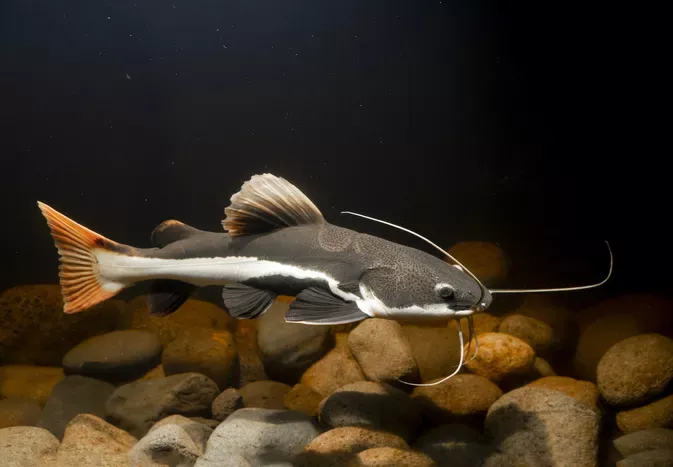Can You Keep a Catfish as a Pet?
Updated on 04/26/24

Unveiling the Enigma: Can You Keep a Catfish as a Pet?
Introduction:
The murky depths of aquariums have long been home to the enigmatic catfish, captivating hobbyists with their diverse appearances, fascinating behaviors, and air-breathing abilities. But while these aquatic creatures may seem like intriguing companions, the question remains: are catfish suitable pets for the average hobbyist?
This comprehensive guide will delve into the intricacies of catfish ownership, exploring their unique characteristics, habitat requirements, dietary needs, and potential health issues. By equipping you with invaluable information, we aim to empower you to make an informed decision about whether a catfish can harmoniously fit into your aquatic sanctuary.
Chapter 1: Understanding Catfish Diversity
Catfish, a diverse group of fishes belonging to the order Siluriformes, inhabit a myriad of aquatic environments worldwide. They are characterized by their elongated bodies, whisker-like barbels, and lack of scales.
* Variety of Species: The catfish family encompasses over 2,900 recognized species, ranging from diminutive Corydoras pygmaeus to the colossal Mekong giant catfish. This vast array offers a spectrum of sizes, colors, and behaviors to suit various aquarium setups.
* Bottom-Dwelling Nature: Most catfish are benthic dwellers, meaning they spend their time on or near the bottom of the aquarium. They utilize their barbels to navigate, locate food, and communicate with conspecifics.
Chapter 2: Essential Habitat Requirements
Creating an optimal habitat for your catfish is paramount to ensuring their well-being. Here are some key considerations:
* Aquarium Size: The size of your aquarium will depend on the specific species of catfish you choose. As a general rule, provide at least 10 gallons per adult fish.
* Substrate: Catfish prefer fine sand or gravel substrate, which provides a soft and comfortable surface for their barbels.
* Hiding Places: Catfish are shy creatures that require plenty of hiding places to retreat to. Provide caves, driftwood, or plants for them to feel secure.
* Filtration: A robust filtration system is essential to maintain water quality. Choose a filter that is rated for an aquarium twice the size of your catfish's habitat.
Chapter 3: Dietary Considerations
Catfish are predominantly omnivorous and feed on a variety of foods. However, their specific dietary needs vary depending on their species.
* Protein Sources: Meaty foods such as brine shrimp, bloodworms, and small fish are essential for providing catfish with their daily dose of protein.
* Plant Matter: Many catfish enjoy eating algae, plants, and fruits. Providing them with a balanced diet that includes plant-based foods promotes their overall health.
* Feeding Frequency: Feed adult catfish once or twice a day, and limit the amount to what they can consume in a few minutes.
Chapter 4: Common Health Issues
Like any organism, catfish can experience various health issues if their needs are not met adequately. Here are some common problems to watch out for:
* Skin and Gill Parasites: Parasites such as Ich and anchor worms can infest catfish, causing skin irritation and respiratory problems.
* Bacterial Infections: Dirty water or stress can lead to bacterial infections, which can manifest as skin lesions, eye problems, or lethargy.
* Swim Bladder Disease: This condition can affect catfish, causing them to lose their buoyancy and swim erratically.
Chapter 5: Lifespan and Compatibility
The lifespan and compatibility of catfish vary significantly depending on the species.
* Lifespan: Some catfish species, such as the smaller Corydoras, can live for up to 10 years in captivity, while larger species like the Mekong giant catfish can reach 60 years or more.
* Compatibility: Some catfish species are peaceful and can be kept with other tankmates, while others are more territorial and may require a species-only setup.
Conclusion:
Keeping a catfish as a pet can be a rewarding experience for dedicated hobbyists. By providing proper habitat, nutrition, and care, you can create a thriving environment for these fascinating creatures. Research the specific species you are interested in, and ensure that you can commit to the long-term care requirements before embarking on this aquatic adventure. Let the enigmatic catfish enrich your aquarium and bring a touch of the deep into your home.
Explore More Pets

Freshwater Aquarium Filters
How to Deal With Cloudy Aquarium Water

Saltwater Aquarium Filters
How Do You Remove Chloramines From Tap Water?

Freshwater Aquariums & Habitat
Can I Keep My Koi Fish Inside?

Saltwater Aquariums & Habitat
14 Best Floating Plants for Your Aquarium

Freshwater Fish Health
How to Treat Ich on Freshwater Fish

Saltwater Fish Health
Fin Rot in Aquarium Fish

Freshwater Aquarium Filters
How to Do Aquarium Water Changes

Saltwater Fish Health
How Do Fish Get Parasites?